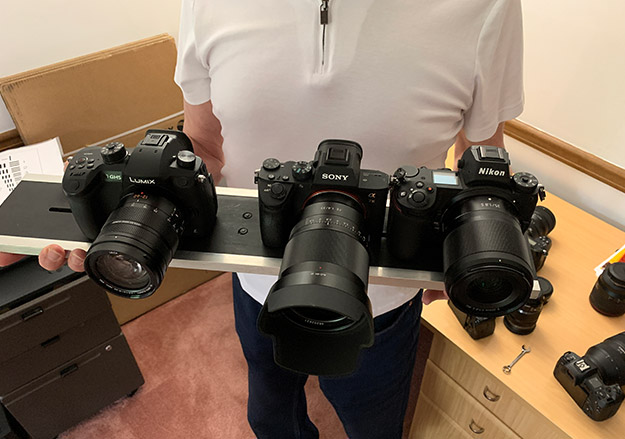Walking I.S. mini-shootout: Nikon Z7 vs Panasonic GH5 vs Sony A7 III
posted Friday, May 3, 2019 at 10:30 AM EDT
An episode in which we bolt 3 cameras to a
board and walk around with them, filming...

When Jaron Schneider covered the video features on the Nikon Z6 recently, we realized that we didn't have any good comparisons of image stabilization between cameras when shooting video.
Video's a really different use case for IS than still photos: On the one hand, the resolution with video is a lot lower, so you don't need to hold things so microscopically stable unlike with still images. On the other hand, though, there's a lot more camera movement to correct for over a longer period of time, especially if you're moving around while filming. The trick is not just to hold things relatively steady, but also to avoid sudden jerks that'll be obvious when watching the videos.
So we really need to add some tests showing how video I.S. performs with different cameras, and William Brawley and I spent an afternoon playing with a few different cameras and lenses (all three cameras were set to the same focal length). We used a rig that let us mount three cameras to the same platform, so they'd all see the same movement and vibration, while we filmed and walked.

I eventually want to make some changes to improve the rig beyond the simple board we used this time, but meanwhile, I thought it would be interesting to look at three popular video-oriented bodies, to see how they compared to each other. The three cameras were the Sony A7 III, the Nikon Z7 (acting as a stand-in for the Z6, since they have the same IS system and actuator), and the Panasonic GH5.
The results were pretty interesting. They also helped us understand what to look for in video I.S. systems, especially the details of what it looks like when they fail.
First, we should say that the walking-around use case is much more challenging for I.S. than just hand-holding and standing still. All three cameras do a pretty good job at stabilization when you're aren't moving around, although Jaron felt he found some twitchy-ness in some of the Z6 video he shot. (In some but not others; he wasn't sure why it seemed present at some times but not others.)
The most obvious result in the test above was that the GH5 does a lot better than the other two when walking. We think that's probably the result of it having more room in its body relative to the sensor size, allowing the sensor to move around more to compensate for camera movement.
In fact, that seems to be the way I.S. systems usually fail with large-movement video recording like this: While compensating for the camera movement, the sensor suddenly bumps up against the limits of its motion. The result is that, after holding stable for a while (a short while in the case of our high-motion video clips above), the image will suddenly jerk or jump.
We suspect that when this happens, the cameras take advantage of the fact that there's going to be a jump in the video image anyway, and so they move the sensor back towards the center of its range of movement, so it will be able to start tracking the camera motion again, rather than just resting against its stop and hoping the camera movement reverses soon. Doing this, there's a bigger jump in the video, but the total time the image is moving will be less.
It isn't easy to see this effect as separate from the jumps caused by the larger jolts each time I take a step, but if you watch closely, you can see the video from the Z7 and A7 III jerking at different times than each other -- showing that it's accumulated displacement rather than a specific camera movement that causes the jump. Overall, the Z7 does better than the A7 III, but both are outclassed by the GH5 in this regard.
The bottom line is that, while all three cameras do pretty well in stationary hand-held use, if you want to shoot while walking with either the A7 III or Z7, you'll want to use a gimbal.
We'd like to do more tests like this, on a more regular basis, but want to make a slightly different rig before doing so, that would have up to 4 cameras at a time all see more similar movement. (With the cameras bolted to a board like this, the two on the outside are going to see a bit more up/down movement than the one in the middle, as the rig as a whole can easily tilt right or left. As it turns out in this case, the A7 III was the one in the middle, and it did the worst, so we can't attribute its lesser performance to some inherent unfairness in how the cameras were set up and held. It could be the case that the advantage of the Z7 over the A7 III is a bit greater than seen here because the Z7 was likely seeing at least some more motion than the Sony was.
What do you think? Would you like to see more tests like this? What do you think of the test itself? Let us know in the comments...